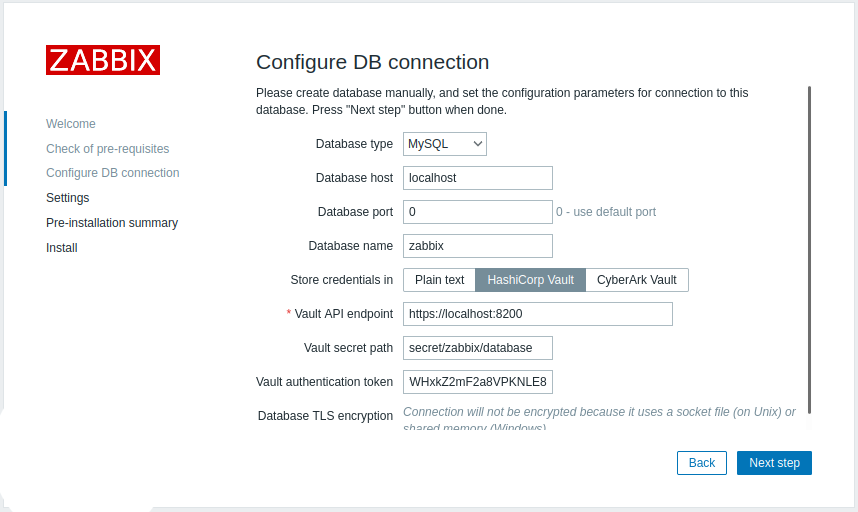Is this not what you were looking for? Switch to the current version or choose one from the drop-down menu.
HashiCorp configuration
This section explains how to configure Zabbix to retrieve secrets from HashiCorp Vault KV Secrets Engine - Version 2.
The vault should be deployed and configured as per the official HashiCorp documentation.
To learn about configuring TLS in Zabbix, see Storage of secrets section.
Database credentials
Access to a secret with database credentials is configured for each Zabbix component separately.
Server and proxies
To obtain database credentials for Zabbix server or proxy from the vault, specify the following configuration parameters in the configuration file:
- Vault - specifies which vault provider should be used.
- VaultToken - vault authentication token (see Zabbix server/proxy configuration file for details).
- VaultURL - vault server HTTP[S] URL.
- VaultDBPath - path to the vault secret containing database credentials. Zabbix server or proxy will retrieve the credentials by keys 'password' and 'username'.
Zabbix server also uses these configuration parameters (except VaultDBPath) for vault authentication when processing vault secret macros.
Zabbix server and Zabbix proxy read the vault-related configuration parameters from zabbix_server.conf and zabbix_proxy.conf upon startup.
Zabbix server and Zabbix proxy will additionally read "VAULT_TOKEN" environment variable once during startup and unset it so that it would not be available through forked scripts; it is an error if both VaultToken and VAULT_TOKEN contain value.
Example
In zabbix_server.conf, specify:
Vault=HashiCorp
VaultToken=hvs.CAESIIG_PILmULFYOsEyWHxkZ2mF2a8VPKNLE8eHqd4autYGGh4KHGh2cy5aeTY0NFNSaUp3ZnpWbDF1RUNjUkNTZEg
VaultURL=https://127.0.0.1:8200
VaultDBPath=secret/zabbix/databaseRun the following CLI commands to create required secret in the vault:
# Enable "secret/" mount point if not already enabled, note that "kv-v2" must be used
$ vault secrets enable -path=secret/ kv-v2
# Put new secrets with keys username and password under mount point "secret/" and path "secret/zabbix/database"
$ vault kv put secret/zabbix/database username=zabbix password=<password>
# Test that secret is successfully added
$ vault kv get secret/zabbix/database
# Finally test with Curl, note that "data" need to be manually added after mount point and "/v1" before the mount point, also see --capath parameter
$ curl --header "X-Vault-Token: <VaultToken>" https://127.0.0.1:8200/v1/secret/data/zabbix/databaseAs a result of this configuration, Zabbix server will retrieve the following credentials for database authentication:
- Username: zabbix
- Password: <password>
Frontend
To obtain database credentials for Zabbix frontend from the vault, specify required settings during frontend installation.
At the Configure DB Connection step, set Store credentials in parameter to HashiCorp Vault.

Then, fill in additional parameters:
| Parameter | Mandatory | Default value | Description |
|---|---|---|---|
| Vault API endpoint | yes | https://localhost:8200 | Specify the URL for connecting to the vault in the format scheme://host:port |
| Vault secret path | no | A path to the secret from where credentials for the database shall be retrieved by the keys 'password' and 'username' Example: secret/zabbix/database_frontend |
|
| Vault authentication token | no | Provide an authentication token for read-only access to the secret path. See HashiCorp documentation for information about creating tokens and vault policies. |
User macro values
To use HashiCorp Vault for storing Vault secret user macro values, make sure that:
- The Vault provider parameter in the Administration -> General -> Other web interface section is set to HashiCorp Vault (default).

- Zabbix server is configured to work with HashiCorp Vault.
The macro value should contain a reference path (as path:key, for example, secret/zabbix:password). The authentication token specified during Zabbix server configuration (by 'VaultToken' parameter) must provide read-only access to this path.
See Vault secret macros for detailed information about macro value processing by Zabbix.
Path syntax
The symbols forward slash and colon are reserved. A forward slash can only be used to separate a mount point from a path (e.g. secret/zabbix where the mount point is "secret" and "zabbix" is the path) and, in case of Vault macros, a colon can only be used to separate a path/query from a key. It is possible to URL-encode "/" and ":" if there is a need to create a mount point with the name that is separated by a forward slash (e.g. foo/bar/zabbix, where the mount point is "foo/bar" and the path is "zabbix", as "foo%2Fbar/zabbix") and if a mount point name or path need to contain a colon.
Example
In Zabbix: add user macro {$PASSWORD} with type Vault secret and value secret/zabbix:password

Run the following CLI commands to create required secret in the vault:
# Enable "secret/" mount point if not already enabled, note that "kv-v2" must be used
$ vault secrets enable -path=secret/ kv-v2
# Put new secret with key password under mount point "secret/" and path "secret/zabbix"
$ vault kv put secret/zabbix password=<password>
# Test that secret is successfully added
$ vault kv get secret/zabbix
# Finally test with Curl, note that "data" need to be manually added after mount point and "/v1" before the mount point, also see --capath parameter
$ curl --header "X-Vault-Token: <VaultToken>" https://127.0.0.1:8200/v1/secret/data/zabbixNow the macro {$PASSWORD} will resolve to the value: <password>

